When I first arrived in Rome in 1972 as a young bride, I could count the number of “foreign” restaurants on one hand. Now I only remember three: French “Charly’s Saucerie” between the Colosseum and St. John Lateran, Japanese “Hamasei” downtown near Piazza di Spagna, and the “Cantina Tirolese”, near St. Peter’s, a favorite with Cardinal Ratzinger before he was elected pope. All three are still in existence and delicious.
If foreign cuisine was unavailable so was Italian from regions beyond central Italy. Again the only ones I remember, which also still exist, are Tuscan “Il Buco” between the Pantheon and St. Ignatius, “Al Bolognese” on Piazza del Popolo, still renown for people-watching, and “Da Cesarina”, famous for tortellini, off the Via Veneto near the American Embassy. Almost all other restaurants served typically Roman or abruzzese fare with Mamma and other female family members cooking and the men serving. They were all closed on Monday.

“Da Cesarina”
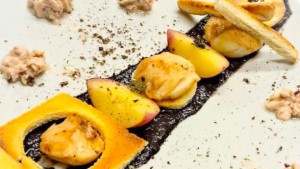
Saint Jacques at “Charly’s Saucerie”

Ratzinger’s favorite table
There were several reasons for Rome’s culinary “provincialism”. Until the boom of the 1960s, Italians almost always lived permanently where they were born unless they immigrated abroad; the majority of the population was too poor to travel for pleasure. If they immigrated within Europe, they returned home to their birthplaces during August vacations or for elections. If they immigrated farther afield, to North or South America or later to Australia, many never returned to Italy.
For Italy immigration was a one-way outbound street. Except for Mussolini’s disastrous attempt at colonization in the Horn of Africa, Italy did not have an overseas empire like France, England, Portugal, Belgium, and The Netherlands. There were no colonists to speak-of who came to study in Italy and remained so were homesick for their homeland’s cuisine. There were no pocket-neighborhoods of immigrants in Italian cities who opened restaurants for their homesick or for curious locals. On the contrary, Italian immigrants opened restaurants in their new homes for their homesick fellow-immigrants with the ingredients they could find in their new homes. It wasn’t until Gualtiero Marchesi won his three Michelin stars and Tony May introduced authentic Italian cuisine to the United States that Italy and Italian cuisine became the rage. Nota bene: Italian-American cuisine is similar, but not the same as Italian.
The first ethnic restaurants to open in Rome were Chinese. They opened en masse in 1996 just before Hong Kong returned to China. Although they’re numerous, located in every neighborhood, sometimes several even on the same street, and particularly popular with young people thanks to their low prices, the majority of Rome’s Chinese restaurants is nothing to write home about. There are a few exceptions, however. One is 63 Ristorante Cinese at no. 63 Via delle Fornaci across the street from St. Peter’s for its generous “all you can eat” menu, a valid alternative to its neighboring Italian tourist traps. Another is elegant “Green T.” at Via del Pie’ di Marmo 28 near the Pantheon, also home to a tearoom and a clothing and interior design boutique. Here the specialty is traditional “Peking Duck” in three different preparations, but also not to be missed are sesame and shrimp rolls, wan ton algae, salmon and calamari tempura with washabi sauce and black rice in a lotus leaf, and Chairman Mao’s favorite, pork belly from Hunan braised in rice wine with caramelized sugar.
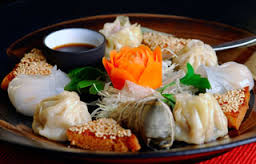
At “Green T.”
Yet another, “Mr. Chow” at Via Genova 29/a, now in its second generation, is a favorite among Rome’s still-growing number of local Chinese residents. Among its specialties: chicken with black mushrooms and bamboo, wonton soup, five-colored rice, spring rolls, roasted ravioli, crispy duck, and crispy spaghetti with beansprouts.
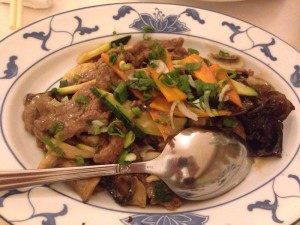
“Mr. Chow”‘s Beef Chop Suey
Another longtime Asian favorite is the Nguyen family’s “Thien Kim” at Via Giulia 201 for a full-immersion course in Vietnamese gastronomy. Follow their advice: rice spaghetti with roast shrimp, Imperial rolls, sweet-and-sour soup, spicy meat satay, and shrimp with bamboo and ginger. The fruit-based sweets are also mouth-watering.
During the past decade sushi has invaded Rome. In addition to restaurants, numerous bars serve sushi at Happy Hour and supermarkets prepare it before your eyes on site. For the best in town, head straight to “Hamasei” or to “Zen Sushi” at Via degli Scipioni 243 not far from the Vatican. Sit at the bar and feast your eyes as the wide choice of dishes passes by on a conveyor belt. The only glitch: No reservations.
Another mouth-watering sushi conveyor belt is at Sushisen at Via Giuseppe Giuletti not far from F.A.O. (the United Nation’s Food and Agriculture Organization). It’s a bit off-the-beaten-track, but only a 15-minute ride on bus no. 23 from the Vatican. Other venues for top sushi are “Hasekura” at Via dei Serpenti 27 not far from the Colosseum (the washabi ice cream is to-die-for), “Rokko” at Passeggiata di Ripetta 15 near Piazza del Popolo, and “Doozo” at Via Palermo 51/53, which is a restaurant (Oh! for those homemade sweets), bookstore, and art gallery, rolled into one.

“Zenobia”
As for non-Oriental ethnic restaurants, their arrival is barely a decade old and often due to people escaping the horrors of wars and famines worldwide. Now Italy has become a sought-after immigrant destination, if ironically, since with youth unemployment at 40%, many young Italians are being forced to immigrant again. I can recommend “Surya Mahal” at Piazza Trilussa 50 for its vegetarian (45 euros), meat (55 euros), or fish (65 euros) tasting menus of Indian delights or “Tiger Tandoori at Via del Pigneto 193 for very traditional dishes; although all off-the beaten-track, but worth detours,“Mesob”, “Massawa” and “Asmara” to anyone homesick for Africa; Turkey and the Middle East are well-represented by “Tokapi at Via Nomentana 81 and ”Zenobia” at Piazza Dante 23, which offers a spectacle of belly dancers on Friday and Saturday evenings; for authentic Mexican and Tex-Mex cuisine and cocktails “El Pueblo”, “La Cucaracha” and “T-Bone Steak”, all three near Vatican City, and for authentic “Born in the USA” bite into hamburgers, fried chicken, carrot cake and brownies at “The Perfect Bun” at Largo del Teatro Valle 4 across from Piazza Navona.
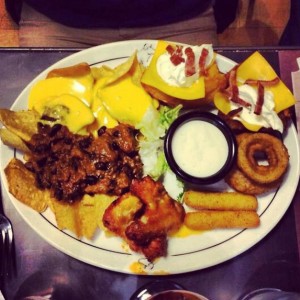
At “T-Bone Steak”
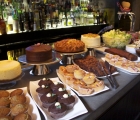
Sweets selection at “the Perfect Bun”
At the time of this writing, a month after its opening, “Me Geisha”, founded by Italian-American businessman Giuseppe Tuosto two years after his successful restaurant with the same name at Via Roma 59 in Salerno, is probably still Rome’s newest restaurant. Its menu is Japanese fusion. Just off Corso Vittorio Emaneule II, next door to the Chiesa Nuova, 500 meters from Piazza Navona, and across the Tiber from Via della Conciliazione and Vatican City, its slightly over-cramped ambience is appropriately located at Via dei Filippini 4 (Filipinos Street, www.megeisha.it, tel. -39-349-9055245). Like its address its innovative executive chef, Rodelio Aglibot, was born in the Philippines.
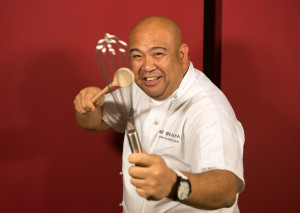
“Food-Buddha” Rodelio Aglibot
Known the world over as “The Food Buddha” because of his dedication to his heritage and his Zen approach to creative menu development, Aglibot was raised in Hawaii and California. “At a very young age I had my first inkling that my professional calling would be cooking. I grew up in a very Catholic family, which gave me a strong sense of unity and of respect for others. A tragedy in life is not to find one’s passion…a greater tragedy is to know one’s passion and deny oneself of its treasures,” he told me at “Me Geisha”’s inauguration on December 1. He credits his parents as his early culinary mentors: his father Reggie, now a retired chef, and his mother Sally, a great cook in her own right. “Follow your heart,” they told me. “Cook for love and you will be loved. A great chef does not create great dishes…a great chef inspires great chefs.”
After attending UCLA, Aglibot pursued his culinary aspirations at the City College of San Francisco’s Hotel and Restaurant Program. Upon graduation in 2000 he was immediately accepted as a yearlong apprentice at the Greenbrier Resort in West Virginia, which he still calls “culinary boot camp”. Next Aglibot was involved in five restaurant openings in three years including the well-known “Koi Restaurant” in Los Angeles, where as Executive Chef he started his ascent.
In June 2004 he opened his own “Yi Cuisine” in Los Angeles to critical acclaim. Food and Wine named it one of the “Best New Asian Restaurants” in the USA and The LA Times gave it a glowing 2-star review.
Now based in Chicago and Los Angeles, a tireless creative soul who likes to travel the world, since 2006 Aglibot has been responsible for the openings of some 30 restaurants in Chicago, New York, Los Angeles, Memphis, Hong Kong, Cincinnati, Las Vegas, and Salerno to name a few. He’s been a guest on many national television programs in USA for his New Asian cuisine and featured in many print publications. He was recently named one of “StarChefs” 500 Chefs to know.
In addition, during the late summer of 2015 he launched “Food Buddha Gourmet”, his namesake frozen food line. Not to omit that one of his proudest accomplishments is his non-profit charity named “In Chef’s Hands”, which connects individuals with special needs who have a passion for food and cooking with established chefs in the Chicago area.
Aglibot visited Italy for the first time eight years ago and Rome five. What convinced him to open a restaurant here, he told me, “was the large range of available fresh seasonal ingredients. All the ingredients at ‘Me Geisha’ are local or ‘Kilometer 0’ except the tuna, which comes from Sicily, and a few special fish from Japan. I’m romantic and believe in the value of traditions and culture. Like music food is a language, which helps overcome cultural barriers and creates communication channels between people. To be a chef is a privilege. It is the only art form that uses all five senses; that’s how special it is.”
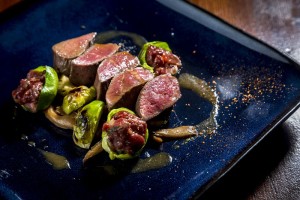
Meat Tataki
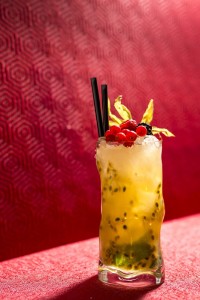
Maracuja cocktail
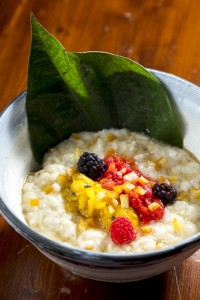
Rice Pudding with ginger and fruit
Although Aglibot will expand the choices on “Me Geisha”’s menu, at the inauguration he served: as Starters: crispy rice with red tuna from Sicily, lard from Colonnato and chili; Salmon “Gunkan”; Firecracker Roll; Sushi Trio: Salerno Roll with Tempura Shrimp and slightly spicy Tuna; Raw Hamachi (amberjack) with Ponzu (Japanese vinegar); Nigiri (sushi) of scallop with Yozu Kosho (paste of fermented chili peppers and salt); Hearth and Ocean: Ramen of broth with pork, chicken and prosciutto dumplings (36-hour preparation); Glazed Chilean sea bass with cucumber salad; Meat Tataki (slightly grilled and chopped) with washabi and mushrooms; Desserts: Rice pudding with ginger and seasonal fruit. Be sure to order a house fruit-based cocktail.
For two other delicious fusion locations: again Japanese/Brazilian, go to either branch of “Temakinho”, the original in the trendy neighborhood of “Monti” at Via dei Serpenti 16 (on the same street “Hasekura”), or near St. Peter’s at Borgo Angelico 30. The fruit-based non-alcoholic drinks are a child’s delight.
Another new culinary phenomenon: If you peek into an authentic Roman trattoria’s kitchen today, you will probably not see an Italian cook. He will probably be from North Africa (particularly for pizza) or Bangladesh. Perhaps in a generation, if his children follow in his footsteps, as in England and in France, they will be able to become restaurateurs, to afford to own their own restaurant like the Vietnamese Nguyen family and to put their homeland’s cuisine on the world map.
